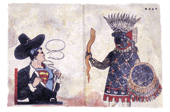With Rounder Records set to reissue more than 100 CDs of original field recordings made by the late Library of Congress folklorist Alan Lomax, the 38 songs on The Alan Lomax Collection Sampler offer a manageable introduction to the numerous musical cultures to which Lomax devoted his life. Culled from the collection’s 18 volumes and accompanied by more than 70 pages of informative liner notes and scholarly commentary, the sampler follows Lomax on his far-flung travels as he records everyone from Woody Guthrie and blues legend Son House to devotional singers in Trinidad and prisoners in a Mississippi penitentiary.
Using photographs to make a statement about the cult of images might seem like a contradictory notion — and it might have been had Lauren Greenfield, author of Fast Forward: Growing Up in the Shadow of Hollywood, exposed her subjects without also allowing them to tell their stories. Together with candid testimonies of what it’s like to grow up in Los Angeles, “the trademark capital of adolescence,” Greenfield’s striking images — a 10-year-old Eloise-wannabe admiring herself in her hotel-home’s bathroom mirror; a 13-year-old boy ogling a go-go dancer’s breasts at his $90,000 bar mitzvah; and an 18-year-old gang member signing for the camera as his buddies run from the police — document a cultural moment defined by kids who’ve never wanted to be young.
exposed her subjects without also allowing them to tell their stories. Together with candid testimonies of what it’s like to grow up in Los Angeles, “the trademark capital of adolescence,” Greenfield’s striking images — a 10-year-old Eloise-wannabe admiring herself in her hotel-home’s bathroom mirror; a 13-year-old boy ogling a go-go dancer’s breasts at his $90,000 bar mitzvah; and an 18-year-old gang member signing for the camera as his buddies run from the police — document a cultural moment defined by kids who’ve never wanted to be young.
 Jon Lee Anderson’s Che Guevara: A Revolutionary Life is the first biography of the Argentine rebel to examine the man behind the myth. Using vivid anecdotal details and previously unavailable diaries and letters, the book presents a fully human Guevara. But the question of his ultimate political significance remains sketchy. Perhaps it is symptomatic of our times, in which Guevara remains a pop icon and a romantic symbol of revolt against the status quo — regardless of his actual ideology.
Jon Lee Anderson’s Che Guevara: A Revolutionary Life is the first biography of the Argentine rebel to examine the man behind the myth. Using vivid anecdotal details and previously unavailable diaries and letters, the book presents a fully human Guevara. But the question of his ultimate political significance remains sketchy. Perhaps it is symptomatic of our times, in which Guevara remains a pop icon and a romantic symbol of revolt against the status quo — regardless of his actual ideology.
Three new collections of cut-and-paste music mixology — Deep Concentration (OM Records, 1997), Return of the DJ, Volume II (Bomb Hip-Hop Records, 1997), and Audio Alchemy (Ubiquity, 1997) — all celebrate the art of musical bricolage. While Return of the DJ is a manic hip-hop stew of fractured narratives, squiggling stylus scratches, and chopped-up beats, Audio Alchemy favors slower tempos, darker soundscapes, and more subtle musical collages. All of the above find their way onto Deep Concentration, which features a diverse selection of experimental tracks and even comes with an innovative CD-ROM that lets you dabble in the basics of hip-hop production.
The Ad and the Ego, a documentary by Harold Boihem, explores one of our culture’s most powerful social tools at a time when commercialism seems to have no borders. Interspersing commentary from media critics with hundreds of familiar television ads, the film teaches viewers to think critically about the 1,500 or so images of power, wealth, beauty, and comfort they ingest each day. “Advertising is designed to generate all sorts of anxieties…then to offer the entire world of consumer goods as salvation,” says media critic Bernard McGrane. “One message you will never hear in advertising is ‘You’re OK.'”
 Friendly Cannibals — a genre-busting book from celebrated performance artist Guillermo Gómez-Peña and Chicano visual artist Enrique Chagoya — envisions a cyber-Latino future where love and politics struggle to find a voice amid missing e-mail documents, laptop identity crises, and “ethnocyborgs.” In Chagoya and Gómez-Peña’s Spanglish-speaking world of bicultural cannibalism, a second U.S.-Mexico war has turned the White House into the Brown House.
Friendly Cannibals — a genre-busting book from celebrated performance artist Guillermo Gómez-Peña and Chicano visual artist Enrique Chagoya — envisions a cyber-Latino future where love and politics struggle to find a voice amid missing e-mail documents, laptop identity crises, and “ethnocyborgs.” In Chagoya and Gómez-Peña’s Spanglish-speaking world of bicultural cannibalism, a second U.S.-Mexico war has turned the White House into the Brown House.
 In To Dance With the Devil: The New War on Breast Cancer, veteran journalist Karen Stabiner tells a story that is equal parts engaging and enraging. Chronicling a year in the lives of the UCLA Breast Center, its then-director Dr. Susan Love, and a handful of her patients, the book eloquently describes the many faces and facets of the disease and starkly depicts the high-tech barbarism that passes for treatment options. Love, a maverick within the medical community whose crusade against breast cancer consumes her life, makes for a compelling central figure, and Stabiner’s analysis of the politics of breast cancer research is right on the money. But it is ultimately the individual stories of the women battling the disease — narratives that capture bravery and humor, irony and fear — that make the book truly memorable.
In To Dance With the Devil: The New War on Breast Cancer, veteran journalist Karen Stabiner tells a story that is equal parts engaging and enraging. Chronicling a year in the lives of the UCLA Breast Center, its then-director Dr. Susan Love, and a handful of her patients, the book eloquently describes the many faces and facets of the disease and starkly depicts the high-tech barbarism that passes for treatment options. Love, a maverick within the medical community whose crusade against breast cancer consumes her life, makes for a compelling central figure, and Stabiner’s analysis of the politics of breast cancer research is right on the money. But it is ultimately the individual stories of the women battling the disease — narratives that capture bravery and humor, irony and fear — that make the book truly memorable.
















